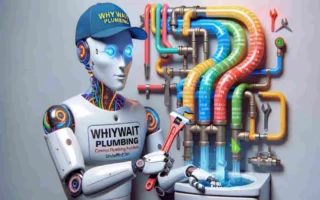Plumbing is an integral part of every home. It keeps water flowing in and out efficiently, ensures sanitation, and allows us to enjoy modern conveniences like showers, sinks, and toilets. But when things go wrong—leaks, clogs, or broken fixtures—you may wonder, “Can I do plumbing in my own house?”
The answer isn’t always straightforward. DIY plumbing can save you money and give you a sense of accomplishment, but it comes with risks. From following local regulations to ensuring safety, there’s a lot to consider.
Understanding Basic Plumbing Systems in Your Home

Before diving into DIY plumbing, it’s essential to understand the basics of your home’s plumbing system. A little knowledge goes a long way toward helping you identify issues and determine whether you can tackle them yourself.
Common Plumbing Components
Here are the primary components of a residential plumbing system:
- Pipes: These carry water to and from different areas of your home. Common materials include PVC, copper, and PEX.
- Valves: Used to control the flow of water, such as shut-off valves for sinks and toilets.
- Fixtures: faucets, sinks, showers, toilets, and other water-using appliances.
- Drainage System: Pipes that remove wastewater from your home.
- Venting System: Vertical pipes that allow air to escape and ensure proper drainage.
How Plumbing Systems Work
Your plumbing system has two main functions:
- Water Supply System: Delivers clean water to your home through pressurized pipes.
- Drain-Waste-Vent (DWV) System: Removes wastewater and prevents sewer gases from entering your home.
Understanding this basic layout will help you visualize how water flows through your home and where problems might occur.
Types of Plumbing Materials
Here’s a quick comparison of common plumbing materials:
Material Advantages Disadvantages
PVC is Affordable, corrosion-resistant can crack in cold temperatures
Copper is Durable, long-lasting, Expensive, and harder to work with
PEX Flexible, easy to Install. Not UV-resistant, may degrade over time
Signs You May Need Plumbing Repairs
Look out for these warning signs that indicate your plumbing system might need attention:
- Dripping faucets or running toilets
- Low water pressure
- Slow-draining sinks or tubs
- Unusual odors near drains
- Water stains or damp spots on walls and ceilings
Legal and Safety Considerations for DIY Plumbing
While DIY plumbing may seem like a cost-effective solution, there are legal and safety factors you can’t ignore.
Local Plumbing Codes and Regulations
Every region has plumbing codes that dictate what work homeowners can legally do themselves. In many areas:
- Minor repairs, such as fixing faucets or unclogging drains, are allowed.
- Significant changes, such as installing new pipes or modifying existing systems, require permits.
When Permits Are Required
Permits are typically required for:
- Installing or replacing water heaters
- Replacing sewer lines
- Adding new plumbing fixtures in renovations
- Re-routing pipes
Tip: Before starting any project, check with your local building authority to understand the rules in your area.
Consequences of Ignoring Legal Rules
Failing to follow regulations can lead to:
- Fines or penalties
- Problems with home insurance claims
- Unsafe plumbing that could cause health hazards like water contamination
Health and Safety Risks
Improper plumbing can result in:
- Leaking pipes, which can lead to water damage or mold growth
- Cross-contamination, where clean water mixes with wastewater
- Gas leaks when working on water heaters or other gas-powered fixtures
Knowing your limits is crucial to avoiding these risks. When in doubt, call a licensed professional.
Tools and Materials Needed for DIY Plumbing Projects
Having the right tools is half the battle. Here’s a list of essentials every homeowner should have in their DIY plumbing kit.
Essential Plumbing Tools
- Wrench Set: Adjustable and pipe wrenches are essential for tightening and loosening fittings.
- Plunger: A fundamental tool for unclogging sinks and toilets.
- Pipe Cutter: For cleanly cutting PVC or copper pipes.
- Plumber’s Tape (Teflon Tape): Used to seal threaded connections and prevent leaks.
- Drain Snake: Helps clear stubborn clogs in drains.
- Bucket and Towels: To manage water spills during repairs.
Recommended Materials
- PVC Pipes and Fittings: Lightweight and easy to work with for minor repairs.
- Compression Fittings: Ideal for temporary fixes or connecting pipes without soldering.
- Plumber’s Putty: Used to create watertight seals around fixtures.
Budgeting Tips
If you’re new to DIY plumbing, start with cost-effective tools. Professional-grade tools are great, but they can be expensive and aren’t always necessary for basic repairs.
Common DIY Plumbing Projects You Can Do Yourself

Not all plumbing tasks require professional expertise. Here are some simple projects you can confidently handle on your own.
Fixing Leaking Faucets and Showerheads
- Replace worn-out washers or cartridges.
- Use plumber’s tape to reseal threads.
Unclogging Drains
- Use a plunger or a drain snake to remove blockages.
- Avoid harsh chemicals that can damage pipes.
Installing New Fixtures
- Replacing a toilet or sink is straightforward with the right tools and instructions.
- Follow the manufacturer’s installation guidelines.
Repairing Running Toilets
- Replace the flapper or adjust the float arm.
- Check for leaks in the fill valve.
By starting with these manageable tasks, you can build confidence in your plumbing abilities.
Step-by-Step Guide for Basic Plumbing Repairs
Let’s walk through a simple repair: fixing a leak under the sink.
Prepare Your Workspace
- Shut off the water supply to the sink.
- Place a bucket under the pipes to catch water.
Identify the Problem
- Check for loose connections or damaged pipes.
- Look for cracks or corrosion.
Make the Repair
- Tighten any loose fittings using a wrench.
- If a pipe is damaged, cut out the section using a pipe cutter and replace it with a new one.
When DIY Plumbing is Not Recommended
Some projects are too complex or risky for homeowners. Here’s when you should call a professional:
- Re-routing Pipes: Requires detailed knowledge of plumbing systems.
- Water Heater Repairs: Involves both plumbing and electrical work.
- Sewer Line Issues: These are messy and require specialized equipment.
- Gas Pipe Connections: Mistakes can lead to dangerous gas leaks.
How to Find Reliable Professional Plumbing Help
If you decide to hire a plumber, follow these tips to ensure you find someone trustworthy:
Questions to Ask a Plumber
- Are you licensed and insured?
- How much experience do you have with similar projects?
- Can you provide a detailed estimate?
Verifying Credentials
- Check online reviews and ratings.
- Ask for references from previous clients.
A good plumber will answer your questions clearly and provide transparent pricing.
Best Practices to Avoid Plumbing Problems

Prevention is always better than repair. Here are some best practices to keep your plumbing system in top shape:
Routine Maintenance
- Clean drains regularly to prevent clogs.
- Inspect pipes for leaks or corrosion.
Water Conservation
- Install low-flow fixtures to reduce water usage.
- Fix leaks promptly to avoid waste.
Seasonal Care
- In winter, insulate pipes to prevent freezing.
- Drain outdoor hoses and shut off outdoor water supplies.
DIY Plumbing Mistakes to Avoid
Even with the best intentions, mistakes can happen. Here are some common errors to watch out for:
- Over-tightening fittings can crack pipes.
- Forgetting to turn off the water supply before starting work.
- Using the wrong tools or materials for the job.
FAQs
Can I legally do plumbing work myself?
Yes, but regulations vary. Check local codes to see what work you’re allowed to do.
What plumbing repairs are easiest for beginners?
Fixing leaks, unclogging drains, and replacing fixtures are great starting points.
How do I know when to stop DIY and call a plumber?
If the job involves permits, gas lines, or extensive pipework, it’s time to call a pro.
What tools do I really need to start DIY plumbing?
Start with a wrench set, plunger, plumber’s tape, and a bucket.
How do I get a plumbing permit in my area?
Contact your local building authority for guidelines on obtaining permits.




